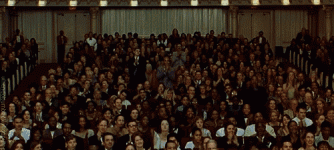3bolt79
Moderator
- Joined
- Jun 28, 2024
- Messages
- 774
- Reaction score
- 1,512
Stratocasters of the 1950’s
The Fender Stratocaster or "Strat" is arguably the best selling electric guitar of all time. It is Fender's best selling model as well. Over the last 70 years, millions upon millions have been produced.
There have been numerous iterations, as well as imitations, and there are even Strat styled guitars in Fender's own Jackson and Charvel lines, not to mention Fender's Squier branded versions. However, certain years of Fender Stratocasters stand out.
Many players, and certainly collectors, feel that the pre CBS Strats (those made before Leo Fender sold the company to Columbia Broadcasting System on January 5th 1965) stand head and shoulders above the rest.
1954
The first Fender Stratocasters were released in April of 1954. At that time, they weren't production line guitars and were essentially hand made. They were the first guitars to feature Leo Fender's new single coil pickups with AlNiCo 3 magnets. These guitars wouldn't be made on a production line until later in the year, sometime in September.
Specs:
-One piece, U shaped Maple neck with "Skunk Stripe" on the back
-Six inline Kluson tuning machines
-Single round string tree on the headstock
-21 Nickel Silver frets
-Single action truss rod with adjustment at the neck heel
-Bakelite/Polystyrene plastics
-Single ply, eight screw hole white pickguard
-Single ply, six screw hole tremolo cavity cover
-White pickup covers and control knobs
-Ash Body with 4 bolt neck attachment plate
-Synchronized Tremolo with six individually adjustable saddles
(A hard tail version was also offered)
-Three single coil pickups with 3 position selector switch
-One volume and two tone controls
Early Strats had the serial number on the back of the tremolo cover. The cover also had six round holes to help facilitate changing strings without removing it.
The Strat was a modular instrument. Fender had designed the instrument with a separate neck and body to simplify production. Further, if a customer damaged a neck, the neck could easily be replaced.
At some point in late 1954, the serial numbers started to be stamped onto the neck plate rather than the tremolo cover.
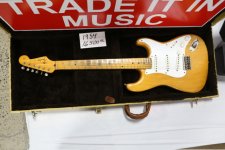
Pictured above is a 1954 Hardtail Stratocaster in natural finish. This photo was snapped at a guitar show, as well as the one below, in 2019. Photos courtesy of Stratomutt at Strat Talk.
Below is a 1954 Stratocaster with Synchronized Tremolo in standard 2 tone sunburst finish.
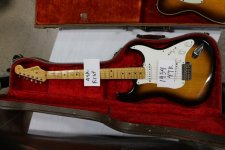
As original 1950’s Strats can be difficult to obtain due to scarcity and cost, the Fender Custom Shop offers vintage spec reissues of guitars from Fender’s storied past. Also, as 2024 is the 70th anniversary of the Stratocaster, Fender is offering an anniversary 1954 Strat in their American Vintage II line as well.
Below is a 50th anniversary Fender Custom Shop 1954 Strat. Photo courtesy of the collection of Jon Day.
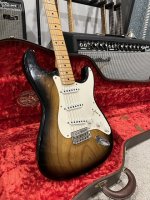
1955
In 1955, Fender made a couple of changes. First, the edges of the headstock were sharper. The previous year's edges had been softened and more rounded. This was likely done to reduce some of the hand work required in producing the necks. Also, the holes in the tremolo cover became larger and were oval shaped. This made changing strings through the holes easier, as trying to change strings through the previous year's small holes could be a challenge.
Below is a pic of an original 1955 model. Photo courtesy of the collection of Marty Tippens.
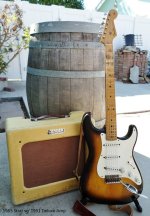
1956
1956 saw a significant change to the body of the Stratocaster. Instead of a 1 or 2 piece Ash body, they started using Alder. Being ever so cost conscious, Leo started using Alder because it didn't require grain filling. This saved money by eliminating the extra time and labor needed before applying the finish.
They also changed the round string retainer (String Tree) to the stamped "butterfly" type that they still use today on certain models, like the American Vintage II series and the Vintera II series. Further, the magnets in the pickups were changed to AlNiCo 5's.
1957
In 1957, the Stratocaster would only see one change, but it was a significant one. Instead of the U profile used in previous years, the necks received a "hard" V profile.
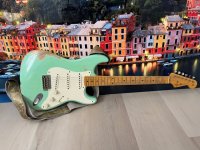
Pictured above is a Fender Custom Shop 1957 Stratocaster. Photo courtesy of Larry K. Willa.
1958
The year would see a change from the larger, hard V profile to a smaller, softer V. Additionally, the standard finish would change from the previous 2 tone sunburst to a three tone sunburst of yellow/red/black.
Not liking to waste parts, there were some guitars that still had the harder V profile and some bodies still came with a 2 tone finish, but they were phased out during the year as remaining parts got used up.
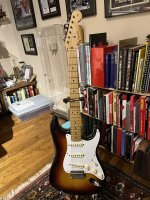
Above is an original 1958 Stratocaster. Photo courtesy of Wammy at Strat Talk.
1959
To close out the decade, the Fender Stratocaster saw even more changes. The most significant being a 2 piece neck, with a "slab" Brazilian Rosewood fingerboard. The V profiles of the previous two years changed to a C profile. Gone was the "Skunk Stripe" on the back of the neck as the truss rod channel was now routed in the top of the neck, and covered by the fingerboard.
The plastics were changed from the previous Bakelite to plastics that are quite similar to what Fender uses today. The 3 ply white/black/white pickguard and the other plastic parts were longer lasting and less prone to cracking. The pickguard now had 11 screw holes for mounting.

Above top center is a transitional 1959 Strat, still sporting a Maple neck and 8 hole single ply pickguard. Photo courtesy of Statomutt at Strat Talk.
Note the "Ashtray Cover" over the bridge. Many players would pull those off (they just snapped into place) as they interfered with palm muting. Some players would set them on top of their amps and tap their cigarette ashes in them. Hence the nick name.
2024 is the 70th anniversary of the Stratocaster. There have been some fantastic Strats that have came from all decades of it's production. What are your favorite decades and models?
The Fender Stratocaster or "Strat" is arguably the best selling electric guitar of all time. It is Fender's best selling model as well. Over the last 70 years, millions upon millions have been produced.
There have been numerous iterations, as well as imitations, and there are even Strat styled guitars in Fender's own Jackson and Charvel lines, not to mention Fender's Squier branded versions. However, certain years of Fender Stratocasters stand out.
Many players, and certainly collectors, feel that the pre CBS Strats (those made before Leo Fender sold the company to Columbia Broadcasting System on January 5th 1965) stand head and shoulders above the rest.
1954
The first Fender Stratocasters were released in April of 1954. At that time, they weren't production line guitars and were essentially hand made. They were the first guitars to feature Leo Fender's new single coil pickups with AlNiCo 3 magnets. These guitars wouldn't be made on a production line until later in the year, sometime in September.
Specs:
-One piece, U shaped Maple neck with "Skunk Stripe" on the back
-Six inline Kluson tuning machines
-Single round string tree on the headstock
-21 Nickel Silver frets
-Single action truss rod with adjustment at the neck heel
-Bakelite/Polystyrene plastics
-Single ply, eight screw hole white pickguard
-Single ply, six screw hole tremolo cavity cover
-White pickup covers and control knobs
-Ash Body with 4 bolt neck attachment plate
-Synchronized Tremolo with six individually adjustable saddles
(A hard tail version was also offered)
-Three single coil pickups with 3 position selector switch
-One volume and two tone controls
Early Strats had the serial number on the back of the tremolo cover. The cover also had six round holes to help facilitate changing strings without removing it.
The Strat was a modular instrument. Fender had designed the instrument with a separate neck and body to simplify production. Further, if a customer damaged a neck, the neck could easily be replaced.
At some point in late 1954, the serial numbers started to be stamped onto the neck plate rather than the tremolo cover.

Pictured above is a 1954 Hardtail Stratocaster in natural finish. This photo was snapped at a guitar show, as well as the one below, in 2019. Photos courtesy of Stratomutt at Strat Talk.
Below is a 1954 Stratocaster with Synchronized Tremolo in standard 2 tone sunburst finish.

As original 1950’s Strats can be difficult to obtain due to scarcity and cost, the Fender Custom Shop offers vintage spec reissues of guitars from Fender’s storied past. Also, as 2024 is the 70th anniversary of the Stratocaster, Fender is offering an anniversary 1954 Strat in their American Vintage II line as well.
Below is a 50th anniversary Fender Custom Shop 1954 Strat. Photo courtesy of the collection of Jon Day.

1955
In 1955, Fender made a couple of changes. First, the edges of the headstock were sharper. The previous year's edges had been softened and more rounded. This was likely done to reduce some of the hand work required in producing the necks. Also, the holes in the tremolo cover became larger and were oval shaped. This made changing strings through the holes easier, as trying to change strings through the previous year's small holes could be a challenge.
Below is a pic of an original 1955 model. Photo courtesy of the collection of Marty Tippens.

1956
1956 saw a significant change to the body of the Stratocaster. Instead of a 1 or 2 piece Ash body, they started using Alder. Being ever so cost conscious, Leo started using Alder because it didn't require grain filling. This saved money by eliminating the extra time and labor needed before applying the finish.
They also changed the round string retainer (String Tree) to the stamped "butterfly" type that they still use today on certain models, like the American Vintage II series and the Vintera II series. Further, the magnets in the pickups were changed to AlNiCo 5's.
1957
In 1957, the Stratocaster would only see one change, but it was a significant one. Instead of the U profile used in previous years, the necks received a "hard" V profile.

Pictured above is a Fender Custom Shop 1957 Stratocaster. Photo courtesy of Larry K. Willa.
1958
The year would see a change from the larger, hard V profile to a smaller, softer V. Additionally, the standard finish would change from the previous 2 tone sunburst to a three tone sunburst of yellow/red/black.
Not liking to waste parts, there were some guitars that still had the harder V profile and some bodies still came with a 2 tone finish, but they were phased out during the year as remaining parts got used up.

Above is an original 1958 Stratocaster. Photo courtesy of Wammy at Strat Talk.
1959
To close out the decade, the Fender Stratocaster saw even more changes. The most significant being a 2 piece neck, with a "slab" Brazilian Rosewood fingerboard. The V profiles of the previous two years changed to a C profile. Gone was the "Skunk Stripe" on the back of the neck as the truss rod channel was now routed in the top of the neck, and covered by the fingerboard.
The plastics were changed from the previous Bakelite to plastics that are quite similar to what Fender uses today. The 3 ply white/black/white pickguard and the other plastic parts were longer lasting and less prone to cracking. The pickguard now had 11 screw holes for mounting.

Above top center is a transitional 1959 Strat, still sporting a Maple neck and 8 hole single ply pickguard. Photo courtesy of Statomutt at Strat Talk.
Note the "Ashtray Cover" over the bridge. Many players would pull those off (they just snapped into place) as they interfered with palm muting. Some players would set them on top of their amps and tap their cigarette ashes in them. Hence the nick name.
2024 is the 70th anniversary of the Stratocaster. There have been some fantastic Strats that have came from all decades of it's production. What are your favorite decades and models?
Last edited:
